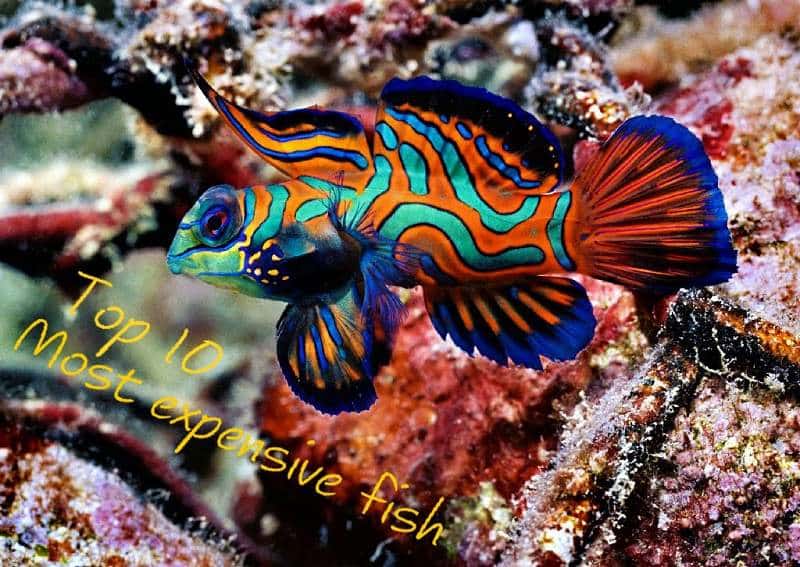
These pretty fish will burn a hole in your bank account.
Pretty fish are expensive fish, and this is true almost everywhere in the world. Those of you who have aquariums at home know very well what an amazing experience it is to be able to look at some of the world’s rarest and most beautiful fish every day.
It’s true that some of these tropical fish require plenty of attention, and some need very special food. However, at the end of the day, it’s definitely worth it to be able to admire some of these amazing sea creatures at a glance.
Speaking of worth, some of the world’s most beautiful fish would set you back a few thousands of dollars, and some could even go as high as $100k. You’d have to be pretty passionate about pretty fish in order to spend this much money on them, but let’s find out exactly why these fish cost so much in the first place. It can’t be all about beauty, right? Rarity must have something to do with it, or maybe the difficulty of the catch.
In any case, stay tuned for our top 10 of the most expensive and beautiful fish in the world!
10. Candy Basslet ($2,000).
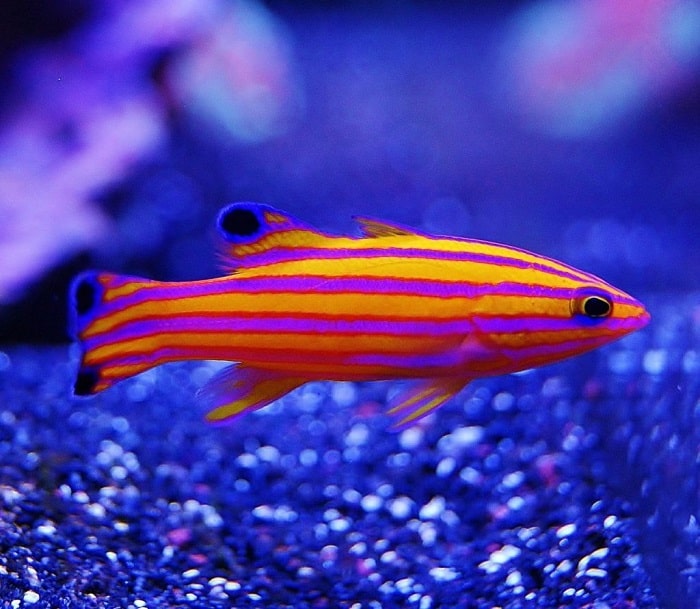
Going by the scientific name of Liopropoma Carmabi, the Candy Basslet is one of the world’s prettiest and most expensive fish, but it’s definitely not the priciest on our list. With a price tag of $2.000, this is fish is actually quite affordable, and as it happens, it’s also one of the best aquarium fish in the world for a number of reasons. First of all, it’s quite resilient, and it’s not very had to feed. It’s also important to point out that it doesn’t grow much, and this makes it ideal for pretty much any coral reef aquarium.
Appearance.
What makes the Candy Basslet stand out among its peers is the unique color of its body. It’s actually a combination of bright lavender and red lines against an orange body, which looks absolutely superb from every angle.
The colors are so bold that they can be quite difficult to photograph sometimes, as they tend to bloom quite a bit on camera. This fish generally won’t exceed 2 1/2 inches in size throughout its life, but it makes up for its small size with a colorful look. Another interesting thing to note is that you can’t tell the males from the females by just looking at the Candy Basslet. Therefore, it’s probably best if you give them their own space.
In its natural habitat, this pretty fish lives in the tropical Atlantic Ocean. It inhabits the Bahamas and the Florida Keys, the eastern Caribbean, and the islands of Curacao, Bonaire, and Ascension. Spottings have been reported in the northern coast of South America as well.
It’s not an easy fish to get a hold of, which is probably why it is so rare and expensive.
Diet and Behavior.
Generally a shy fish, the Candy Basslet will become bolder over time if its surroundings permit it. However, it’s perfectly normal for it to be a bit shy at first, so don’t count on too many appearances until it gets accustomed to its new home.
If you’re going to pay $2.000 for one of these beautiful fish, you should know what and when to feed it. One thing to keep in mind is that it will eat pretty much any shrimp or crab that it can fit in its mouth. For this particular species, this isn’t too much of a problem, but if you’re going for larger species such as Wrasse Bass, it’s definitely a good idea to separate them.
As for food in general, the Candy Basslet will eat pretty much all meaty seafood. This includes squid, clam, enriched brine shrimp, Mysis shrimp, and shredded krill. It could also get accustomed to flake and pellet foods over time, but not all do.
9. Wrought Iron Butterflyfish ($3,800).
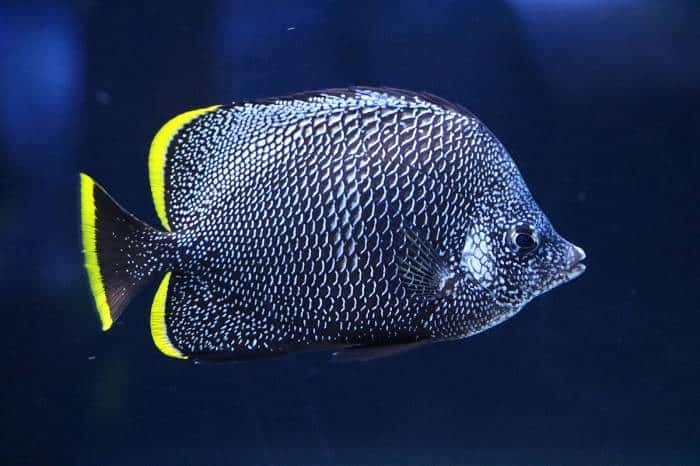
At the time of writing, the Wrought Iron Butterflyfish sells for about $3,800 at various retailers, but pricing is bound to change as the years go by. Also known scientifically as Chaetodon Daedalma, this fish is rarely seen in the United States, as it is rarely imported. This makes it one of the rarest fish to get ahold of on our list, but if you try hard enough, you’ll definitely find a place that has it in stock. Even though it’s not recommended to keep the Wrought Iron Butterflyfish in a coral environment, there have been some successful cases over the years.
Appearance.
When it comes to looks, this is undoubtedly one of the most beautiful fish in the world, even though it’s not exactly the most colorful. its name comes from its obvious scale patterns, which resemble wrought iron designs. The back end of the fish, as well as the tail section, usually boast bright yellow sections that contrast nicely with the dark, wrought iron look. As far as size is concerned, the Wrought Iron Butterflyfish usually reaches about 6 inches, but some can go as far as 7 inches.
Diet and Behavior.
These are very peaceful fish that can be kept alone or in groups of 3 or 5. They play with each other and interact nicely, which means that you won’t have to worry about any incidents when you’re not looking. Diet-wise, these voracious eaters prefer meaty foods and some algae based foods. They can be fed caught Salmon meat, as well as Cod and Tuna, as long as the pieces are cut down to about 4mm.
Even though it’s not a difficult fish to keep from a dietary or behavioral point of view, the Wrought Iron Butterflyfish is quite picky when it comes to water quality. As long as you keep it in pristine condition, though, you should be fine.
8. Neptune Grouper ($6,000).
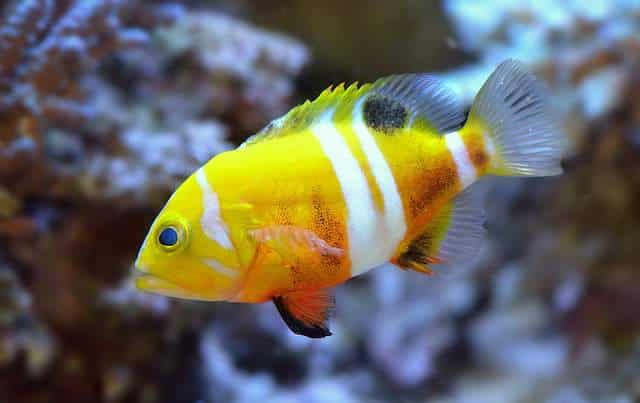
Like we mentioned before, the price tags of these very expensive fish are not just related to their impressive aesthetics. Indeed, some of these fish are notoriously difficult to catch, as some of them live at impressive depths. A fine example is the Neptune Grouper, which generally lives between 260 and 800 feet below water. Priced at $6,000, the Neptune Grouper is one of the world’s most expensive and beautiful fish, but the weird part is that it’s only expensive as long as it is still alive. These fish are sometimes sold at fish markets for just $50.
The problem is that catching a live Neptune Grouper requires costly decompression and transporting techniques, hence the price.
Appearance.
Cephalopholis igarashiensis is a beautiful looking fish that boasts a predominant yellow shade across its body. This yellow look is interrupted by white stripes across the mid-body, and tail, while the eyes sport a deep blue color. The head features light pink stripes, while the belly of the fish is orange and sometimes flaunts black spots, particularly on the lower fin. Some Neptune Groupers have deep red stripes, but those are incredibly rare specimens. Generally, this is a very pleasant fish to look at, but it does require special attention in order to keep healthy.
As the fish ages, its yellowish shade turns into a bright pink all over. This is how you can distinguish a young Neptune Grouper from an older one.
Diet and Behaviour.
Oddly enough, it’s incredibly difficult to find any reliable information regarding the Neptune Grouper’s diet. Generally, this particular fish is served in Japan on street food markets, and it’s not necessarily brought in as a pet very often. Maybe this is because of its price tag, or maybe it’s because it is so rare and difficult to catch. At any rate, we’ll update this section on the Neptune Grouper’s diet and behavior as soon as we manage to find out more.
7. Clarion Angelfish ($7,000).
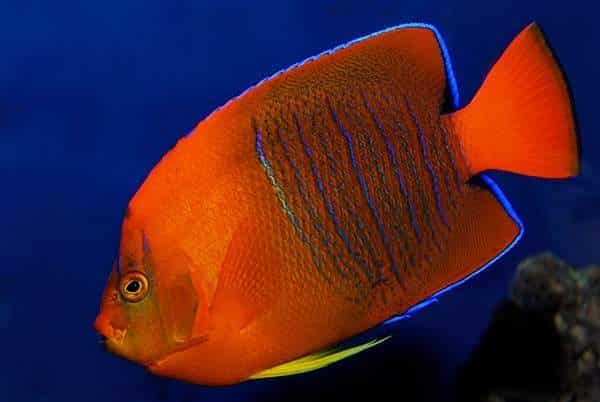
The Clarion Angelfish, otherwise known as Holacanthus clarionensis, is native to Mexico. Actually, most of its population can be found in a single spot in the Revillagigedo Islands, where it lives in a restricted reef habitat of about 50 square kilometers or about 20 square miles. Sadly, the Clarion Angelfish is currently classified as Vulnerable under Criterion D2, but more research needs to be conducted in order to confirm that this species is in actual danger.
Appearance.
The Clarion Angelfish is quite popular in the aquarium trade, mostly because of its beautiful looks and medium size. This multicolored fish boasts a deep shade orange/brown across its body, as well as a beautiful bluish glow on its rear edges. Young ones also present bright blue bars on their sides, which eventually become smaller and disappear as the fish ages. As for size, this specimen can reach up to 7.9 inches in length.
The Clarion Angelfish eats small invertebrates, tunicates, sponges, and various algae. As for behavior, they don’t migrate in the wild, which means that they are used to living in the same place for a long time. They’re quite slow at night and more active during the day.
6. Golden Basslet ($8,000).
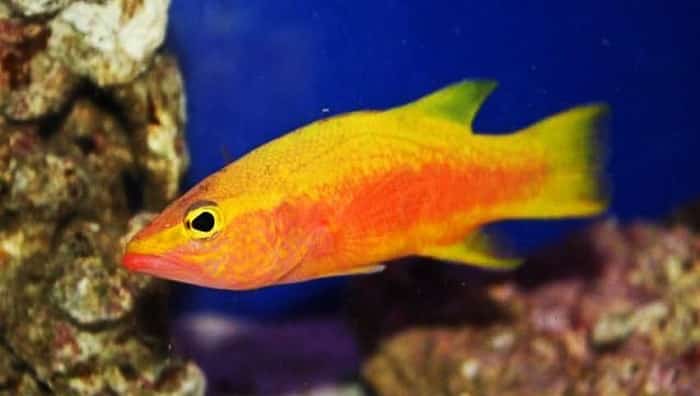
Yet another Basslet that made it on our list is the Golden Basslet, which is also one of the most expensive and prettiest fish in the world. Priced at $8,000, Liopropoma Aberrans can only be caught using a deep-sea submersible, as it lives at depths ranging from 450 to 800 feet. Definitely one of the shier fish out there, it hides in hard-to-reach places and generally keeps its distance from its siblings.
Appearance.
Depending on the lighting, this can actually be a very difficult fish to look at, but in a good way. It’s just that it sports an incredibly vibrant colorway based on a yolk-yellow edge that blends into a saturated, rich tangerine toward the center. As the two colors meet, they form a beautiful honeycomb reticulated pattern that can be observed clearly near the dorsal region of the fish. The fish was discovered for the first time back in 1860.
Other details.
Not much is known about the behavior and particular wildlife diet of the Golden Basslet. This fish made its first appearance in the aquarium trade in 2011, so it’s still a relative newcomer to the scene. Oddly enough, this fish behaves quite differently when compared to other members of the same family, as it prefers to swim openly while still in the reach of a rocky shelter.
When it comes to temper, you should keep just one male Golden Basslet in your tank, as they can be quite aggressive towards other males. It will eat finely chopped fresh or frozen marine fish, as well as squid and vitamin-enriched brine shrimp.
5. Bladefin Basslet ($11,000).
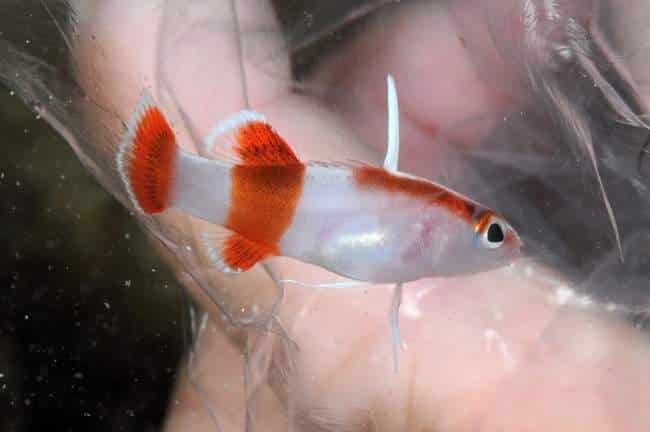
The Bladefin Basslet is another extremely rare fish, which can only be caught using a submersible. Measuring in at about 1.5 inches or 3cm, this unique looking reef fish lives at depths of 500 feet, and it was collected by a submersible in Curacao for the first time. Since then, it became quite a popular yet vastly unaffordable tank fish, as it was sold on numerous occasions for more than $10,000.
Appearance and appeal.
The Bladefin Basslet is a very small fish, but it makes up for its size with an incredibly beautiful mix of colors. These aren’t vibrant or eye-catching colors, mind you, but that blend of white and stark red definitely has its own unique appeal. You don’t have to be an expert to realize that this is a rare and expensive reef fish, and that’s exactly why this one costs so much.
4. Masked Angelfish ($20,000).
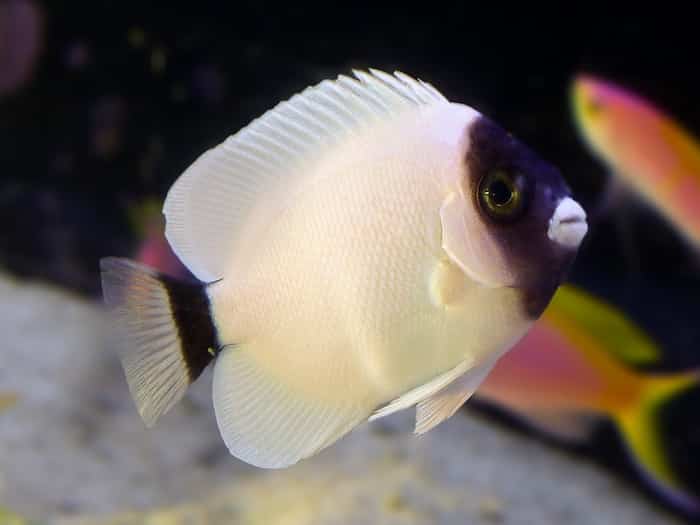
While there are plenty of colorful fishes on our list, the Masked Angelfish actually impresses with a monochrome look and a very beautiful masked figure. Genicanthus personatus lives in the Northwestern Hawaiian Islands, at the very edge of conventional diving limits. Its $20,000 price tag is owed to its unique appearance, true, but also to its rarity. The Masked Angelfish is one of the highest profile marine aquarium fish in the world, and for good reason.
Another thing that makes this particular fish special is the way it changes genders throughout its life. As protogynous hermaphrodites, these fish start out as females and eventually turn into males.
Appearance.
A fully grown female Masked Angelfish boasts an all-white body color with yellow pelvic fins, a black tail, and a black mask. The male retains the black tail fin, but many other parts of its body turn to a yellow-orange color, including the face and the edge of its dorsal and pelvic fins. Just so you can understand the rarity of this fish better, keep in mind that only one or two live specimens were collected each year over the past decade.
3. Peppermint Angelfish ($20,000+).
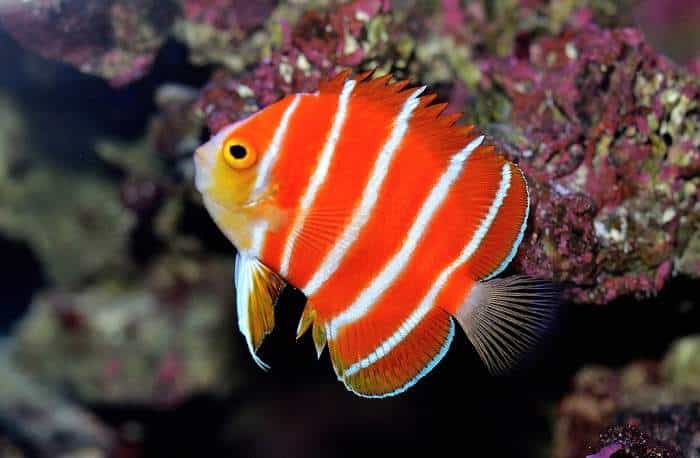
It’s difficult to measure the exact worth of the Peppermint Angelfish, mainly because this fish surfaced (no pun intended) with various price tags over the years. At first, it was purchased for $30,000 by a collector and was put on display. However, more specimens arrived on the market in the following years, with some boasting much more collector-friendly price tags of about $19,000. That’s still a lot of money to pay for a 2.7-inch exotic fish.
Location and appearance.
The Peppermint Angelfish inhabits tropical reefs in the eastern-central Pacific around the Cook Islands and Rarotonga. It is a relatively shy fish, as it often hides among rocks and reef cliffs. Also known as Centropyge boylei, it lives at depths between 170 and 400 feet. It boasts a memorable appearance, with a bright orange body complemented by beautiful, clean white stripes.
2. Freshwater Polka Dot Stingray ($100,000).
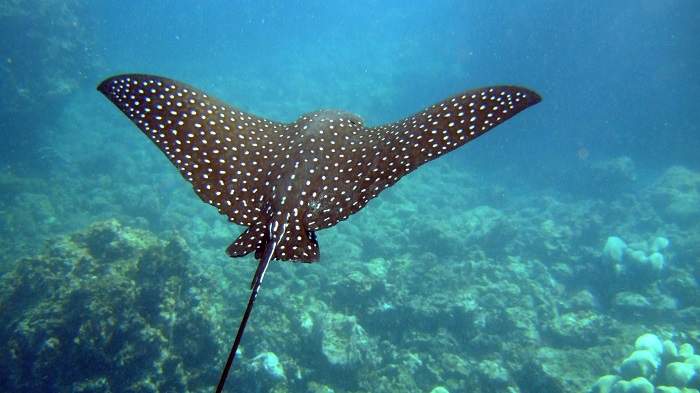
The last two fish on our list come with some ridiculously high price tags. For $100,000, the Freshwater Polka Dot Stingray is one of the most expensive fish in the world, and definitely the most expensive aquarium fish in Taiwan. Also known as the Xingu River Ray, it can be found in Brazil’s Xingu River, and it can reach up to 18 inches in diameter. It’s also worth noting that females are usually larger than males. While most stingrays give birth to around four young ones per litter, the Polka Dot Stingray deliver seven to eight specimens at a time.
Other details.
We know that Polka Dot Stingrays have very good eyesight, all thanks to a pair of protruding eyes that allow them to see what’s above. They mostly eat fish and aquatic invertebrates, as well as freshwater snails and crabs. During the day, this ray buries itself into the sand and remains mostly undetected by other marine life species. At night, it starts to hunt, and it repeats this cycle constantly.
1. Platinum Arowana ($300,000 – $400,000).
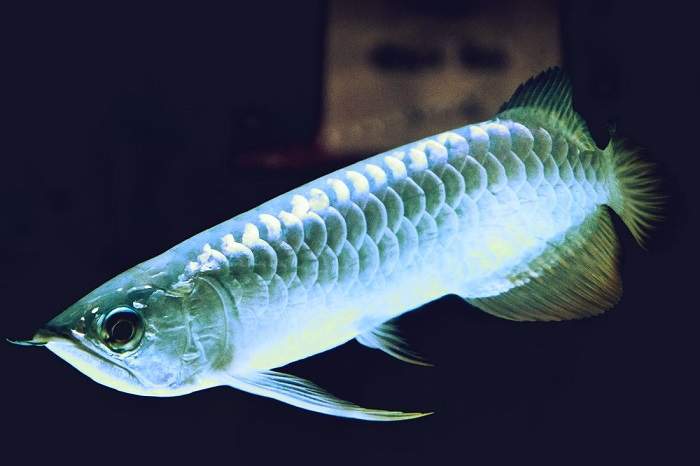
It’s hard to believe that a fish would be worth almost half a million dollars, but here we are! The Platinum Arowana is widely regarded as the world’s most expensive fish, and this makes sense, right? After all, it has Platinum in its name. Jokes aside, the Platinum Arowana is an incredibly beautiful fish. Some even believe that it brings good luck, but if you’re rich enough to afford one of these, you’re probably quite lucky already.
Most Platinum Arowanas that are being sold in the aquarium trade were not caught in the wild, as this species is currently endangered. Instead, they are sold alongside a certificate, and they even have embedded microchips. They are notoriously difficult to breed, as they can grow quite large, and they require very clean water at all times. As far as looks go, they have gorgeous metallic gold-like scales, and the platinum color is owed to a very rare genetic mutation.

3 Comments
this is a amazing article i love it this is awesome
i love rasing tropical and expensive fishes do u have any suggestion for me to start
People on your newsletter must love you. This content is pure 100 gold